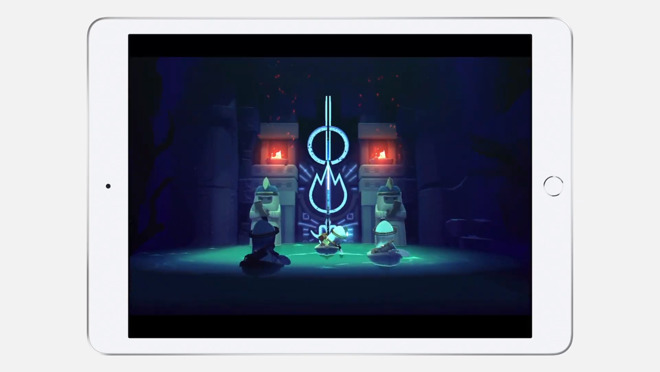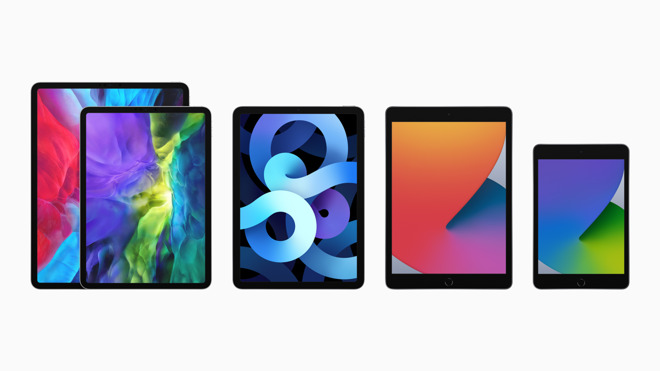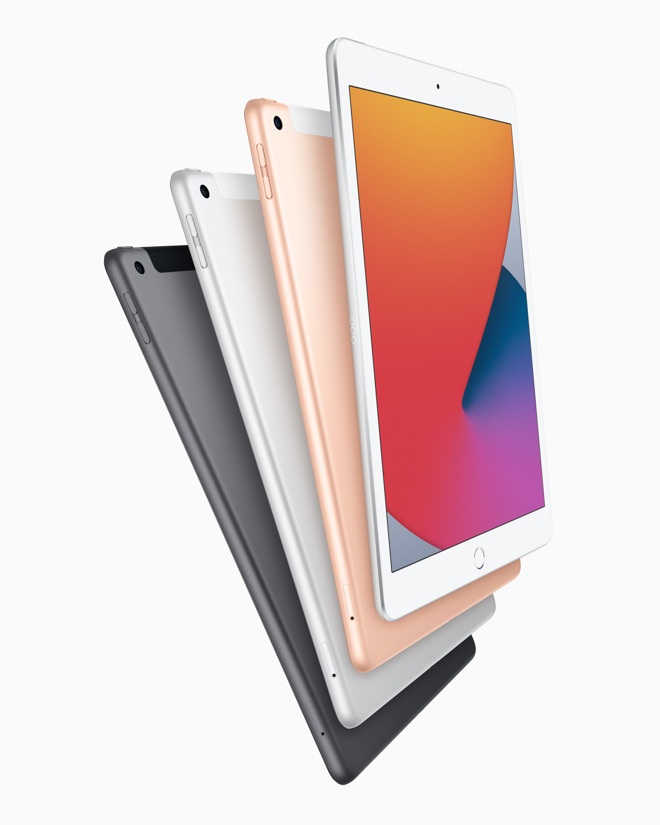Apple updates eighth-generation iPad with A12 processor
Apple has updated the entry-level iPad, with the new eighth-generation model bringing the powerful A12 processor to the table.

Apple's eighth generation iPad
The low-end of the iPad line retains the same 10.2-inch screen size that the seventh generation introduced, and most of the other specifications are the same.
However, the standout feature in the new iPad is the A12 Bionic processor, versus the A10 in the seventh-generation iPad. Previously found in the third-generation iPad Pro line, the A12 Bionic processor is six-core, versus dual-core, and uses big.little technology, meaning that tasks that require lower power are done on the high-efficiency cores, and use less battery power.

Apple's entire iPad lineup
If the processor in the eighth-generation iPad is identical to the third-generation iPad Pro, the single-core benchmark increases by nearly 50%. The multi-core performance is what varies the most, with the A12 more than double the speed of the A10 processor.
The eighth-generation iPad retains the same 10.2-inch Retina non-laminated display that the seventh generation model had, at 2160 x 1620 pixels, at 500 nits brightness. It also keeps Apple Pencil support.
Lightning is retained on the eighth-generation iPad, as is 802.11ac (Wi-Fi 6) support. Bluetooth 4.2 is also retained, versus the Bluetooth 5.0 on the iPad Air and iPad Pro lines. A conventional Touch ID sensor is also retained.

Colors available for the eighth generation iPad
Prior to the unveiling of the eighth generation iPad, Apple last released the seventh generation model during the "By Innovation Only" event in September 2019. We found it to be a worthwhile advancement of the entry-level iPad line, with it an iteration of the technology, rather than an advancement in any big way.
Pricing remains the same, with the 32GB model starting at $329. Orders begin on Tuesday, with units available on Friday.

Apple's eighth generation iPad
The low-end of the iPad line retains the same 10.2-inch screen size that the seventh generation introduced, and most of the other specifications are the same.
However, the standout feature in the new iPad is the A12 Bionic processor, versus the A10 in the seventh-generation iPad. Previously found in the third-generation iPad Pro line, the A12 Bionic processor is six-core, versus dual-core, and uses big.little technology, meaning that tasks that require lower power are done on the high-efficiency cores, and use less battery power.

Apple's entire iPad lineup
If the processor in the eighth-generation iPad is identical to the third-generation iPad Pro, the single-core benchmark increases by nearly 50%. The multi-core performance is what varies the most, with the A12 more than double the speed of the A10 processor.
The eighth-generation iPad retains the same 10.2-inch Retina non-laminated display that the seventh generation model had, at 2160 x 1620 pixels, at 500 nits brightness. It also keeps Apple Pencil support.
Lightning is retained on the eighth-generation iPad, as is 802.11ac (Wi-Fi 6) support. Bluetooth 4.2 is also retained, versus the Bluetooth 5.0 on the iPad Air and iPad Pro lines. A conventional Touch ID sensor is also retained.

Colors available for the eighth generation iPad
Prior to the unveiling of the eighth generation iPad, Apple last released the seventh generation model during the "By Innovation Only" event in September 2019. We found it to be a worthwhile advancement of the entry-level iPad line, with it an iteration of the technology, rather than an advancement in any big way.
Pricing remains the same, with the 32GB model starting at $329. Orders begin on Tuesday, with units available on Friday.

Comments
If you want something functionally different, get an Air or a Pro.
No new design for the X anniversary? Not even for Pencil?
(Still find it funny how Apple is reusing old chips and still kick the knockoffs asses with them)
I assume this is still Pencil generation one...
I’m curious - just what radical new design did you have in mind? As others have said, this is an entry level device at a great price that just works.
This is the baseline model. Ten years after the introduction, there are exactly two "base" models: iPad, and iPad mini. SO CONFUSING!!
I don't think A10 has anything to do with the slowness that you observe in 2018 entry level iPad. A10 is plenty fast for basic operations/use cases that you are describing. Even today, there are plenty of Android low-end/mid-range phones launched with Qualcomm SoCs (SD 665/710/712/720/730 etc) which have raw CPU performance comparable to A10 (and less than half GPU performance). And none of them freeze for basic tasks for 5 seconds like what you mention.
The problem lies somewhere else, most likely the RAM. The budget iPad 2018 has only 2 GB of RAM and that is the Apple's planned obsolescence at work there. And you are seeing the downside of that decision by Apple which hampers your user experience to the point of necessity to upgrade. The 2019 iPad/2020 iPad/2019 iPad Air/2019 iPad mini all have 3 GB RAM which could become a bottleneck for iOS 15 or 16. I am yet to find any link which mentions about the RAM in 2020 iPad Air, so will wait for more info to be made available before commenting on that. It would be a shame if it also has 3 GB RAM. Apple should provide adequate RAM for the lifespan of the device, not bare minimum for the iOS version at which the device is launching and cripple the user experience for subsequent years.